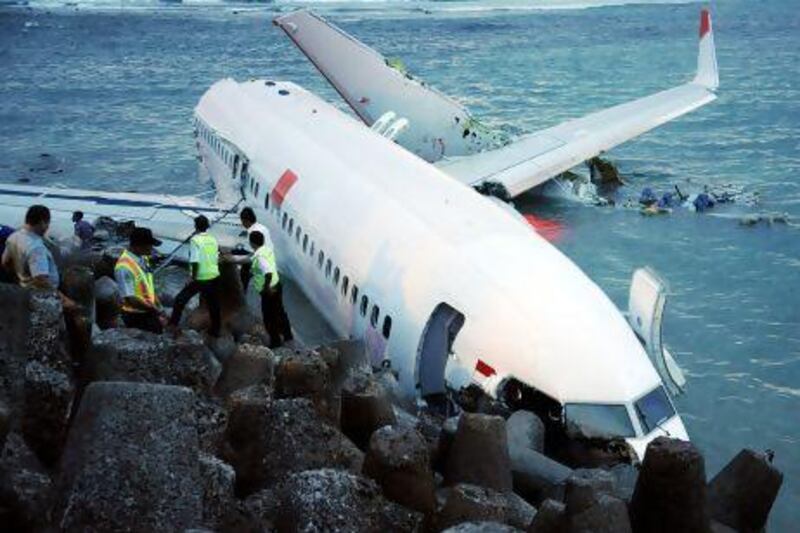JAKARTA // It is the invisible enemy: something all pilots dread as they land at Asia's tropical island resorts.
Wind shear - or the sudden change in wind speed and direction - is particularly hazardous at landing, but some of the region's best known holiday spots in Indonesia, Thailand, Malaysia and the Philippines do not have detection systems on the ground to warn pilots, according to airport officials.
This phenomenon of turbulent winds is common in equatorial South East Asia. A Lion Air pilot of a new Boeing 737 passenger jet that crashed off Bali only last month told investigators how his plane was "dragged down" by wind into the sea just short of the runway. Remarkably, no one died.
"There are quite violent thunderstorms that are huge. You can easily exceed the capability of the airplane in severe wind shear," said Richard Woodward, a Qantas Airways captain who flies A380s.
"The beauty of having a ground-based system is they can tell in advance if wind shear is present," said Mr Woodward, who has flown in the region for more than 30 years.
A ground warning system, which costs about US$1 million (Dh3.67m), can help spot dangerous winds in the plane's flight path, giving pilots more time to avoid them.
But even as revenues rise and building work on glitzy new terminals charges ahead, officials say the airports at Bali, Koh Samui, Langkawi and Cebu do not have the on-ground wind shear detection equipment.
Both Boeing and Airbus say they have on-board wind-shear detection systems. Combined the two wind shear detection systems give pilots a better chance of flying to safety.
Adverse wind conditions are involved in more than 30 per cent of accidents globally at approach or landing, Airbus says.
Upon hearing a wind shear alarm, the pilot has a matter of seconds to level the wings, apply full engine power and ease the nose up to cancel the landing and avoid the intense patch of turbulence.
The Lion Air budget carrier that crashed last month was caught in an unexpected downdraft in a rain cloud even as the airport reported clear weather, said a source who was briefed on the investigations.
Investigators are likely to examine whether the Boeing 737-800's on-board wind-shear alarm went off, and if it did, when and how the pilot responded, and how the brand-new jet reacted.
None of the airports in Indonesia or the Philippines has low-level wind shear alert systems (LLWAS) on the ground, airport and government officials say.
The Jakarta and Bali airports might get LLWAS next year, according to the Indonesian state weather agency, which is responsible for funding such systems.
"LLWAS is not yet in place in Indonesia, maybe because of budgets," said Syamsul Huda, director for aviation and meteorology at the agency. "I feel it is more safe with the system."
The Malaysian island of Langkawi has an Instrument Landing System (ILS), which helps guide pilots when they cannot see the runway, but does not have a wind shear detection system.
The Thai island of Koh Samui, famed for its reefs and beaches, lacks both an ILS and wind shear detection systems. The country's top beach resort Phuket has both, and nearby Krabi recently installed a wind shear alarm.
Strong winds on approach to the Phuket runway led to pilot errors that resulted in a One-Two-Go plane crashing in 2007, killing 90 people, according to investigators. Budget carrier One-Two-Go, owned by Thai aviation veteran Udom Tantiprasongchai, now flies by the name Orient Thai Airlines.
Airports at top Asian tourist destinations lack detection systems for deadly winds
As revenues rise and building work on glitzy new terminals charges ahead, officials say the airports at Bali, Koh Samui, Langkawi and Cebu do not have on-ground wind shear detection equipment.

Editor's picks
More from the national




